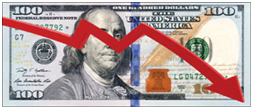De-dollarisation
What is De-Dollarisation
De-dollarisation refers to the replacement of the U.S. dollar by other currencies as the global reserve currency.
Why De-Dollarisation?
- A reserve currency refers to any currency that is widely used in cross-border transactions and is commonly held as reserves by central banks.
- Countries have tried to dethrone the dollar as the global reserve currency for many decades now for various reasons.
- But of late, attempts to de-dollarise have picked up pace in the aftermath of Russia’s invasion of Ukraine last year.
- The U.S. imposed several sanctions that restricted the use of the U.S. dollar to purchase oil and other goods from Russia, and this has been seen by many countries as an attempt to weaponise the dollar.
- Since international transactions carried out in the U.S. dollar are cleared by American banks, this gives the U.S. government significant power to oversee and control these transactions.
- Currently, the Chinese yuan is seen as the primary alternative to the U.S. dollar owing to China’s rising economic power.
The reserve currency advantage
- Other currencies such as the British pound and the French franc have served as international reserve currencies in the past.
- It should be noted that it is the currencies of economic superpowers that have usually ended up being used as the global reserve currency.
- As the economic clout of these countries waned, their currencies faced a similar downfall.
- This was the case, for example, with the British pound which was gradually replaced by the U.S. dollar as Britain lost its status as a global economic superpower in the first half of the 20th century.
- Critics of the U.S. dollar believe that the global reserve currency status gives it unfair privileges over other countries, thus justifying de-dollarisation attempts by many countries.
- It should be noted that when a country’s fiat currency enjoys reserve currency status, it gives the country the power to purchase goods and other assets from the rest of the world by simply creating fresh currency out of thin air.
- However, such irresponsible expansion of the money supply can cause the debasement of the currency and eventually threaten its status as a reserve currency.
- Others point to the expansionary monetary policy adopted by the U.S. Federal Reserve over the decades to argue that this could threaten the U.S. dollar’s status as a global reserve currency.
- The U.S. central bank usually increases the supply of dollars through various means to tackle economic downturns and also to fund the U.S. government’s expenditures.
- But it should be noted that the U.S. Federal Reserve is not the only central bank in the world that has been debasing its currency by engaging in expansionary monetary policy over several decades.
- Other countries have also been expanding their respective money supplies to address their domestic economic problems.
- As long as the U.S. does not debase its currency at a faster pace than other countries, the dollar may manage to hold its value against other currencies and hence its reserve currency status may not come under serious threat.
The popularity of the U.S. dollar
- Many economists argue that the U.S. dollar is not forced on anyone to be accepted as a medium of exchange for cross-border transactions.
- They note that the U.S. dollar is widely used in international transactions because people actually prefer to use the American currency over others for various economic reasons.
- Other currencies that have tried to compete against the U.S. dollar are not as popular as the greenback for carrying out international transactions.
- For example, a recent attempt by India and Russia to carry out trade between the two countries in Indian rupees rather than in U.S. dollars has hit a roadblock because the value of India’s imports from Russia far outweighs its exports to the country.
- This left Russia with excess rupees in hand which it was unwilling to spend on Indian goods or assets, and led to Russian demands for the settlement of bilateral trade in U.S. dollars. So, even Russia, a long-time friend of India and a long-time foe of the United States, preferred to carry out its trade with India using U.S. dollars since the dollar is far more widely acceptable than the Indian rupee.
- The global acceptability of the U.S. dollar has primarily been attributed to the popularity of U.S. assets among investors. It should be noted that the U.S. has been running a persistent trade deficit for decades now (in fact the last time the U.S. ran a trade surplus was way back in 1975).
- That is, the value of its imports has for a long time exceeded the value of its exports to the rest of the world. The excess dollars that the rest of the world accumulates due to the U.S.’s trade deficit has been invested in U.S. assets such as in debt securities issued by the US government.
- The high level of trust that global investors have in the U.S. financial markets, perhaps owing to the ‘rule of law’ in the U.S., is considered to be a major reason why investors prefer to invest in U.S. assets.
- It should, however, be noted that it is not necessary that a country must run a trade deficit for its currency to be accepted as a reserve currency.
- China, for instance, which supplies the world with huge volumes of goods and runs a trade surplus, has been trying to make the yuan a reserve currency.
- However, restrictions placed by the Chinese government on foreign access to China’s financial markets and doubts over ‘rule of law’ in China have adversely affected global demand for the yuan.
| Practice Question
1. What is de-dollarisation? Which currency in the near future has the capability of replace dollar? |




